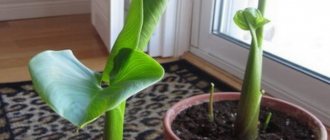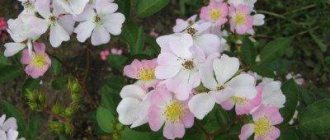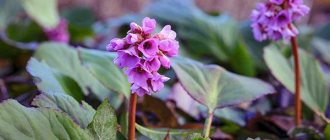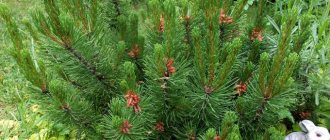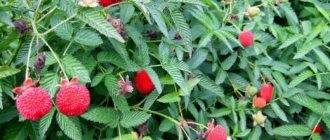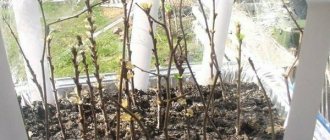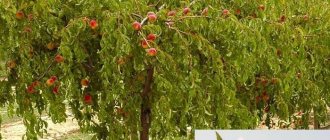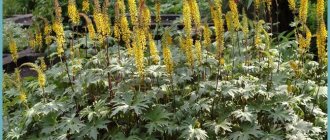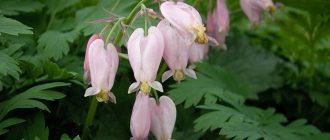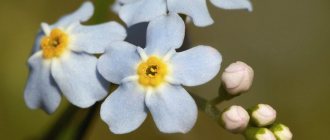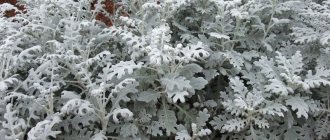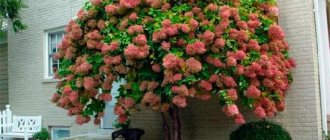Encyclopedia of Plants
Every owner of a country plot strives to create an original and cozy atmosphere in the garden. Plants are always stylish, and most importantly, they give fresh air and unreal visual beauty. But you won’t surprise anyone with ordinary crops anymore, so gardeners are trying to find something more original and unusual. The Rogersia flower can be an excellent solution for planting in the garden. This exotic guest will fit perfectly into modern landscape spaces and will give an unusual look and sophisticated mood to the territory. If you are also interested in how to grow such a handsome man at home, we suggest you read our article.
- 1 Description of Rogers
- 2 Rogersia flower: planting and care in open ground
- 3 How does a plant reproduce?
- 4 Rogersia in landscape design
- 5 Rogersia flower: varieties and types
Description of Rogers
Rogersia flower is a perennial shrub that is a prominent representative of the Saxifraga family. The root system of the crop is taproot. As they develop, horizontal branches acquire new growth buds. The flower forms a semi-spreading shrub; it has a fairly large number of erect or branched shoots. Together with the inflorescences, the height of the bush is up to 120-150 centimeters.
The main decoration of the culture is its decorative foliage. Diameter – up to 0.5 meters. The leaves are located on oblong petioles. They have a rich green color, but can be reddish. They can often change color throughout the year. The shape of the leaves can be visually confused with chestnut leaves.
This crop begins to bloom in July and continues for a month. At this time, paniculate-type inflorescences, consisting of a large number of small flowers, rise above the bush. The petals can be painted in interesting shades - pinkish, snow-white, beige or greenish. The flowers emit pleasant, subtle odors. When the leaves fade, the leaves begin to develop with even greater force.
Rogersia propagation
If there is a need to divide the bushes of a crop, then choose spring or autumn for this. To plant plants, you can use the method of dividing rhizomes . With the onset of autumn, the root system is cut into small pieces (up to 10 cm) and planted in special boxes to a depth of 5-7 cm. For about 4 months, these boxes should be kept in a room with a temperature of +5 - +10ºС, and the soil in them should moisturize periodically. After the crop germinates, it is transplanted into a peat pot, and in the spring - into the ground.
The easiest way to propagate Rogers bushes is by dividing the rhizomes.
Propagation by seeds is used very rarely. And all because the germination rate of seeds is low, and the plants themselves will bloom only after 3-4 years.
Rogersia flower: planting and care in open ground
In order for the Rogersia plant to fully develop, it should choose the optimal place for growing. The ideal solution would be to plant in a shaded area or where the sun's rays are present only in the morning or evening. In addition, take care of good protection from draft winds.
The soil chosen is loose, always with good drainage and fairly fertile. The advantage will be the location of the bush next to a miniature fresh pond, but there should not be constant contact with water. Therefore, the location of groundwater should not be close. Before planting the plant, be sure to dig up the soil, level it and place some peat, compost and humus there. If the soil is heavy and clayey, then add some gravel and sand mixture to it.
You can learn more about caring for Rogers from this video.
Young bushes should be planted to a depth of 8 centimeters. Since the crop is quite large, maintain a certain interval between seedlings. The ideal figure is 0.5-0.8 meters. After planting the bushes, they will need to be mulched and watered.
When caring for crops, you should adhere to the following rules:
- Hydration. Provide the crop with regular irrigation and do not allow the soil to dry out. During the dry period, in addition to moisturizing, you will also need to spray the bushes.
- Weed removal. To prevent excessive evaporation, use mulching. This solution is also ideal in the fight against weeds. If there is no mulching, you will need to loosen the soil and pull out weeds once a month.
- Feeding. On nutritious soils, the bush does not need to be systematically fed. You only need to add a little compost and universal complex fertilizer. This procedure is carried out in the spring. You can also revive the crop during the flowering period. Apply 1-2 fertilizers. To do this, give preference to copper, potassium, zinc, phosphorus and nitrogen. Or formulations containing a large percentage of these substances.
- Wintering. The crop is not afraid of frost, but it must first be prepared for frosty seasons. Leaves, shoots and inflorescences will need to be cut off, and the crown that remains will be trimmed and covered with peat or foliage. In winter, the bushes are also covered with a layer of snow. During snowless or frosty winters, non-woven materials are often used to provide maximum warmth to the crop.
- Pests and diseases. This flower is a natural antiseptic. Therefore, crops are rarely affected by diseases. The only problem is the presence of rot if the soil is too waterlogged. Affected stems and leaves are cut off and destroyed. The remains of the crown are treated with fungicides. Slug settlements are also sometimes found on wet soil. Use eggshells or ash that are scattered around the bushes.
Rogersia perennial planting
The variety belongs to heat-loving crops. For rapid growth and lush flowering, you should follow simple planting rules.
When to plant
It can be planted in autumn or spring. More experienced gardeners, having noticed the good vegetation of the crop after wintering, recommend planting in the fall.
Selecting a location
The shrub does not tolerate exposure to direct sunlight. For planting, it is recommended to give preference to shaded areas, with fertile soil, and protection from drafts. The territory must be large-scale because the bushes grow quite quickly, which can have a detrimental effect on nearby growing varieties.
It is not recommended to plant different varieties in close proximity, because in the process of development they are capable of cross-pollination and lose their varietal characteristics. To prevent freezing, it is necessary to choose an area where the snow melts at the very last moment. It is not recommended to plant in lowlands, in places where melt or rainwater accumulates. The constant presence of moisture in the soil can provoke the process of rotting of the root system, which will subsequently lead to the death of the entire plant.
Remember! Do not plant in open sunny areas. Exposure to direct sunlight will lead to burns on the leaves, which will have a detrimental effect on the decorative properties of the exotic.
Soil preparation
The soil should be fertilized with humus, forest soil with particles of foliage, as well as leaf compost should be added. The substrate on the territory should be light, moist, with a good drainage system.
Landing technology
The landing process has its own characteristics:
- The area intended for planting must be well dug up and loosened, all weeds must be carefully removed.
- Next, the soil is fertilized and nutrients and useful elements are added.
- Holes are dug for seedlings, the diameter of which is slightly larger than the diameter of the root ball.
- A drainage layer is laid at the bottom of each hole to prevent moisture stagnation in the soil.
- Before planting, containers with seedlings are watered abundantly, the flower is carefully removed and placed in the hole.
- The transferred seedling is sprinkled with the prepared substrate; the surface must be lightly compacted.
- The plantings are watered abundantly, the surface is mulched with bark.
How does a plant reproduce?
The Rogersia flower reproduces in several ways.
Young shoots of Rogersia
Let's look at each of them in more detail:
- Seed method. Rogers seeds are most problematic to use for propagation. The fact is that such a process will require a lot of preparation. Seed material is sown in autumn, depth - 1-2 centimeters. To do this, use special boxes containing light and fertile soil. It is better to leave them under a canopy, but outside. Cold stratification is performed for 14-21 days. Then the crops are placed in a warm room, where the air temperature will be +11...15 degrees. After a few weeks, the first shoots will begin to appear. When the seedlings reach 10 centimeters in the air, they dive. With the onset of May, seedlings can be taken outside, but it is better to transplant bushes into open soil in September. Such plants will bloom only after 3-4 years from the moment of planting.
- Dividing bushes. As the bushes grow, they require division. It also promotes rejuvenation. The procedure is carried out in the spring, the cuttings are immediately moved to open soil. Sometimes division is carried out in the fall, but in this case the root system is placed in containers with soil. You will need to dig up the bush and remove the lump of soil. Divide the root so that each division has a growing point. Do not allow the rhizome to dry out; immediately plant the bush in new soil.
- Cuttings. Leaves with a “heel” and petiole take root well. This method of propagation is relevant for use in the summer. When the cuttings are cut, they must be processed using Kornevin. It is recommended to plant crops in moist and light soil. When the bushes are well rooted, they need to be placed in the garden. After replanting the crop, do not forget to save the earthen ball.
Rogers care
Caring for a garden plant is very simple: with the onset of spring, Rogersia is cleared of old leaves, the soil is mulched, and the crop is fed with organic fertilizers. You need to protect the plant from spring frosts using non-woven material.
Attention! If you notice that the roots are slightly peeking out of the soil, then they need to be sprinkled with earth. After the plant has flowered, all flower stalks are carefully cut off, dry and ugly leaves are removed, and closer to autumn, all shoots are cut off.
Rogersia in landscape design
This shrub is impossible to miss. It looks great under trees, next to fences, and the banks of artificial or natural reservoirs.
The flower feels great in the shade of the garden plot
Lush plants will be the ideal backdrop for creating a flower bed, and will hide ugly or empty places. These crops look great in compositions with ferns, bergenia or bells.
Rogersia pests and diseases
The exotic beauty is rarely affected by diseases, because her nutritious juice contains antiseptic components. However, if planting rules are not followed, especially without good drainage, the roots can quickly become covered with rot.
Pests can be slugs and vine snails, less often the foliage is affected by rust fungus. For protection, injured areas are removed, and the remaining stems are treated with fungicides.
If the rules of supervision are not followed, there is a lack of flowering and loss of greenery. Usually such consequences are caused by a lack of moisture. It is necessary to replant the planting and provide additional irrigation.
Drafts and direct rays of the sun in the midday heat provoke the formation of brown spots and dried areas. In such a situation, transplantation and protection from the negative effects of nature are required.
Attention! Treatment is carried out only in warm weather, preferably in the first half of daylight. In this case, the foliage should remain dry.
Rogersia flower: varieties and types
This culture has 8 varieties. But there are also many decorative varieties. Let's look at the most relevant ones:
- Rodgersia aesculifolia. A very popular bush. The height of the shoots is up to 1.8 meters. The bushes have bright green leaves, visually like a chestnut.
Rogersia concochestanifolia
Differs in long petioles. The height of the peduncles is up to 120-140 centimeters. It blooms with white or light pink panicles. They are quite thick. The most popular varieties are Henry and Henrici. They are distinguished by coffee leaves and light pink flowers. - Rodgersia pinnata or pinnate Rogersia. These are low bushes, inflorescences up to 0.6 meters. The leaves are located distant from each other. The leaves visually resemble those of rowan. The inflorescences are distinguished by creamy-delicate or pinkish buds.
Photo of Rogersia pinnate
Flowers awaken later than other species, so flowering is observed later. A common variety is Rogersia chocolate wings or Chocolate Wings . The inflorescences have a wine-red hue, they are located above a beautiful crown. - Rodgersia podophylla or flower Rogersia centifolia/podophylla. It is also called Japanese. The crop can withstand minor droughts.
Rogersia stopifolia or podophyllum
Plant height is up to 150 centimeters. The leaves have a glossy bronze color. It blooms with excellent greenish-cream buds.
Also worth noting is the Rogersia bronze peacock variety . The leaves are quite large and have long petioles. Length – up to 0.45 meters. They have a pleasant bronze tint. It blooms in June; very beautiful pink buds immediately attract attention. Looks great in tandem with cereals and irises.
Features of Rogers
Rogersia is a herbaceous perennial plant. Its root system is taprooted, and in young bushes it is more developed. And in adult and old plants, the rhizome is a modified stem from which adventitious roots extend. The thick rhizomes of this perennial grow directly under the soil surface, and they can cover fairly large areas. This flower feels best in a shaded area with moist and nutritious soil. It should be remembered that it must be protected from gusts of wind and scorching direct rays of the sun.
Rogersia is loved by gardeners because it has spectacular foliage. Its leaf blades are very large and highly textured; they can have a copper, metallic, bronze or brown tint. The foliage is attached to powerful stems, and it comes in varying degrees of dissection (depending on the species). This plant looks great in a rocky garden or in a large rock garden.
The flowering of such a plant is observed in the middle of summer, and it lasts from 4 to 6 weeks. When the bush fades, it begins to rapidly grow foliage. During flowering, paniculate inflorescences are formed, consisting of small and fragrant flowers. They can be painted in various colors: from red and pink to yellow and white. This plant is considered an excellent honey plant, and it requires insects for pollination.
Rogersia is part of the Saxifraga family, and this genus is relatively small. Today, only 5 types of Rogers and several dozen varieties are known. This plant comes from the Japanese island of Honshu, the southeastern part of Asia and Korea. Moreover, some species can be found in Tibet, China and Nepal. Powerful stems can reach a height of up to 1.5 m. However, this depends on whether Rogersia is grown in favorable conditions and what variety it belongs to. The dry fruit is a capsule.
Rogersia - a plant for a shady garden
Mulching the soil for Rogersia
The soil for planting Rogersia should be rich in nitrogen. With a sufficient amount of this element, the leaves of the plant grow large, fleshy and very beautiful. To enrich soil mixtures with nitrogen, humus and soil taken from under leafy trees are added to them. In such soil there is leaf humus and unrotted foliage. When these components are mixed, a light, loose and aerated soil is obtained. Excess moisture will not stagnate in it and oxygen will be able to flow to the roots of the plant. In early spring, when Rogersia sprouts rise 5–10 cm above the ground, the soil at the base of the bush is mulched. Mulch prevents moisture evaporation, weed growth, and in some cases fertilizes the bush itself.
Articles for gardeners and gardeners
How to fertilize the soil in spring?
Growing onions in a bag without soil
Growing roses from cuttings from a bouquet
How to fertilize an apple tree in spring?
